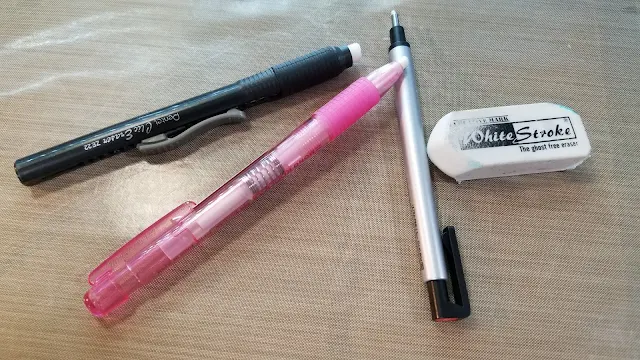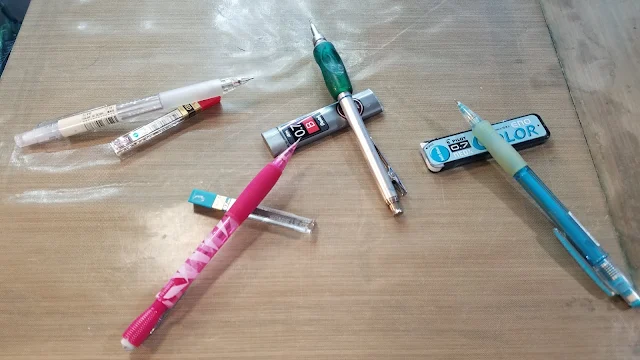Getting To Know: Traditional Comic Materials
What's In My Pencilcase-2018 Edition
Every artist has their preferred tools, but some basics are pretty common from artist to artist.
Basics:
Erasers
Pencils
Ruler
Paper
As an artist, you will eventually develop your own preferences, but hopefully this post can get you off to a strong start!
Pencils
Generally, I prefer mechanical and drafting pencils to wooden, as I hate taking time to sharpen my pencil, and I hate dull leads! I prefer Japanese brands to American brands, as Japanese stationery brands tend to be better designed and better built. However, you can find many Japanese brands even at your local Walmart- Pentel, Zebra, and Uni are all commonly carried.
The exception in my preference comes down to sketching and warmups- for warmups and doodles, I prefer using colored pencils, and frequently use Prismacolor pencils in warm earthtones such as terra-cotta.
What's the difference between Drafting Pencils and Mechanical Pencils?
Mechanical Pencils:
Mechanical pencils can be made from a variety of materials (wood, plastic, metal), and frequently, but not always, feature refillable, replacable lead. They may feature back, side, shake, or even twist advancement of the lead. Mechanical pencils provide a consistent lineweight without need for sharpening.
Drafting Pencils:
Often drafting pencils fall into the category of mechanical pencils, but not always. Lead holders, which are a type of drafting pencil, are not mechanical pencils, and are desigend with a clutch mechanism to hold larger leads (1mm-2mm).
'Drafting pencil' often refers to a metal bodied mechanical pencil with a back advancement. Popular materials include brass and aluminum. Drafting pencils often have knurled metal grips, which can damage your hands, and have no give in the body, which can lead to arthritis over time.
Drafting pencils feature a metal lead sleeve, which protects the lead when it's advanced, and prevents breakage. Many drafting pencils also feature a spring mechanism that acts as a shock absorber- a handy feature for those of us who are heavy handed. Many drafting pencils also include an eraser cap, and a lead indicator, which can be manually changed depending on the lead used.
Lead Holders:
Lead holders hold larger leads (1mm-2mm) that may require sharpening with a lead pointer. Lead holders are all clutch mechanism (a jawed pressure clamp that holds the lead in place), and are typically metal bodied.
I'm Using:
Pilot Color Eno Mechanical Pencil (.7mm, soft pink and soft blue, used for underdrawing)
Pentel Icy (.7mm, contains HB lead, used for sketching)
Pentel Graph Gear 1000, with a Staad pencil grip (.7mm, B lead, used for tight pencils)
Leads
If you're using mechanical pencils or drafting pencils, then you're also going to be using leads. Many pencils come with refills, but as an artist, you may wish to branch out and find your own preferred materials.
Why Non Photo Blue?
Non photo blue (and other colored leads) are frequently used by artists for underdrawing and sketching. Sketching in a colored lead makes it easy to differentiate between construction and details you wish to keep, and you can pencil over these colored leads, ink, or even go straight to watercolor or alcohol marker.
Originally NPB would not scan or photo copy (hence the non photo part). These days, scanners are much more sophisticated, and will pick up NPB, but it's easy to digitally drop light colors such as pink, light blue, and especially yellow. I have tutorials on this blog on how to drop the blues.
I'm Using:
Pentel Hi Polymer HB Lead
Pentel HiPolymer B Lead
Color Eno Soft Blue Lead
Pentel .5mm Red Lead
Colored Pencils
Commonly Used:
Palomino Blackwing Pencils
Palomino 602
Palomino Blackwing Pearl
Col-Erase Colored Pencils (light blue)
Caran d'Ache Sketcher
I'm Using:
Prismacolor Color Pencils- Terra Cotta
Erasers
When selecting erasers, I want erasers that will:
I've tried a lot of erasers over the years, and while I rotate what I use, I do have some favorites that I hope you guys will check out!
I'm Using:
Pentel HiPolymer Eraser
Mono Eraser
White Stroke Eraser
Moo Eraser
Mono Knock Eraser
Pentel Ain Eraser
Mono Zero
Pentel Click Erase
This just refers to the case you use for your daily use art supplies! This is going to vary heavily from artist to artist, and I have several great recommendations in my 2018 Comic Artist Gift Guide. I'm using a Nomadic pencil case that doesn't seem to be commonly available anymore.
So those are my basic, everyday comic supplies! Keep an eye on this blog for more detailed, deeper dives into my comic artist supplies!
Resources Used:
Mechanical Pencil (Wikipedia)
How A Drafting Pencil Works
Ink and Graphite- What is a drafting pencil?
Cult Pens: Guide to Mechanical Pencils
Jackson's Art: Why Use a Clutch Pencil
Every artist has their preferred tools, but some basics are pretty common from artist to artist.
Basics:
Erasers
Pencils
Ruler
Paper
As an artist, you will eventually develop your own preferences, but hopefully this post can get you off to a strong start!
Pencils
 |
| Pencils used to pencil thumbnails and roughs-Pentel Graph Gear 1000 with Staad Pencil Grip, Pilot Color Eno |
 |
| Pencils and Erasers used for thumbnails and roughs stages of comics |
Generally, I prefer mechanical and drafting pencils to wooden, as I hate taking time to sharpen my pencil, and I hate dull leads! I prefer Japanese brands to American brands, as Japanese stationery brands tend to be better designed and better built. However, you can find many Japanese brands even at your local Walmart- Pentel, Zebra, and Uni are all commonly carried.
The exception in my preference comes down to sketching and warmups- for warmups and doodles, I prefer using colored pencils, and frequently use Prismacolor pencils in warm earthtones such as terra-cotta.
What's the difference between Drafting Pencils and Mechanical Pencils?
Mechanical Pencils:
Mechanical pencils can be made from a variety of materials (wood, plastic, metal), and frequently, but not always, feature refillable, replacable lead. They may feature back, side, shake, or even twist advancement of the lead. Mechanical pencils provide a consistent lineweight without need for sharpening.
Drafting Pencils:
Often drafting pencils fall into the category of mechanical pencils, but not always. Lead holders, which are a type of drafting pencil, are not mechanical pencils, and are desigend with a clutch mechanism to hold larger leads (1mm-2mm).
'Drafting pencil' often refers to a metal bodied mechanical pencil with a back advancement. Popular materials include brass and aluminum. Drafting pencils often have knurled metal grips, which can damage your hands, and have no give in the body, which can lead to arthritis over time.
Drafting pencils feature a metal lead sleeve, which protects the lead when it's advanced, and prevents breakage. Many drafting pencils also feature a spring mechanism that acts as a shock absorber- a handy feature for those of us who are heavy handed. Many drafting pencils also include an eraser cap, and a lead indicator, which can be manually changed depending on the lead used.
Lead Holders:
Lead holders hold larger leads (1mm-2mm) that may require sharpening with a lead pointer. Lead holders are all clutch mechanism (a jawed pressure clamp that holds the lead in place), and are typically metal bodied.
I'm Using:
Pilot Color Eno Mechanical Pencil (.7mm, soft pink and soft blue, used for underdrawing)
Pentel Icy (.7mm, contains HB lead, used for sketching)
Pentel Graph Gear 1000, with a Staad pencil grip (.7mm, B lead, used for tight pencils)
Leads
If you're using mechanical pencils or drafting pencils, then you're also going to be using leads. Many pencils come with refills, but as an artist, you may wish to branch out and find your own preferred materials.
Why Non Photo Blue?
Non photo blue (and other colored leads) are frequently used by artists for underdrawing and sketching. Sketching in a colored lead makes it easy to differentiate between construction and details you wish to keep, and you can pencil over these colored leads, ink, or even go straight to watercolor or alcohol marker.
Originally NPB would not scan or photo copy (hence the non photo part). These days, scanners are much more sophisticated, and will pick up NPB, but it's easy to digitally drop light colors such as pink, light blue, and especially yellow. I have tutorials on this blog on how to drop the blues.
Pentel Hi Polymer HB Lead
Pentel HiPolymer B Lead
Color Eno Soft Blue Lead
Pentel .5mm Red Lead
Colored Pencils
Commonly Used:
Palomino Blackwing Pencils
Palomino 602
Palomino Blackwing Pearl
Col-Erase Colored Pencils (light blue)
Caran d'Ache Sketcher
I'm Using:
Prismacolor Color Pencils- Terra Cotta
Erasers
 |
| Left to Right: Pentel Clic Erase, Tombow Mono Knock Eraser, Tombo Zero Eraser, Creative Mark White Stroke |
When selecting erasers, I want erasers that will:
- Not Tear Up My Paper
- Not Cause Ghosting with My Ink
- Don't Smear
I've tried a lot of erasers over the years, and while I rotate what I use, I do have some favorites that I hope you guys will check out!
I'm Using:
Pentel HiPolymer Eraser
Mono Eraser
White Stroke Eraser
Moo Eraser
Mono Knock Eraser
Pentel Ain Eraser
Mono Zero
Pentel Click Erase
Everyday Carry
This just refers to the case you use for your daily use art supplies! This is going to vary heavily from artist to artist, and I have several great recommendations in my 2018 Comic Artist Gift Guide. I'm using a Nomadic pencil case that doesn't seem to be commonly available anymore.
So those are my basic, everyday comic supplies! Keep an eye on this blog for more detailed, deeper dives into my comic artist supplies!
Resources Used:
Mechanical Pencil (Wikipedia)
How A Drafting Pencil Works
Ink and Graphite- What is a drafting pencil?
Cult Pens: Guide to Mechanical Pencils
Jackson's Art: Why Use a Clutch Pencil







Comments
Post a Comment